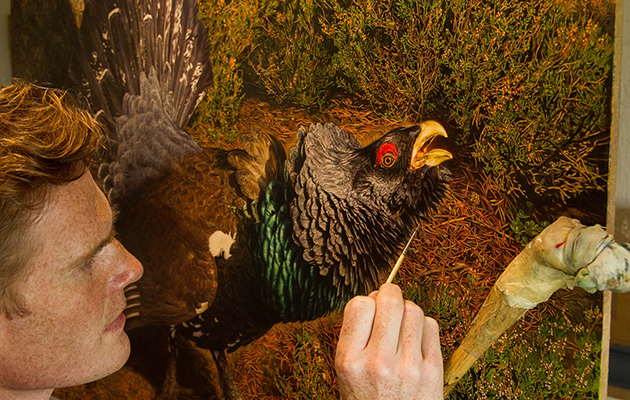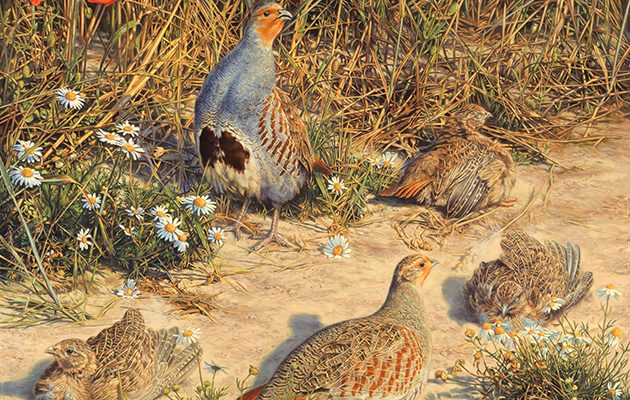To capture his subjects is a painstaking process for Jonathan Pointer, with the background vital to the work’s impact, as he explains to Janet Menzies
Context and authenticity is vital to Jonathan Pointer. Janet Menzies discovers how he encourages viewers of his wildlife art to examine the whole scene.
For more sporting artists, Debbie Harris’ atmospheric oil paintings were inspired by an early love for dogs and hunting. And John Frederick Herring Snr was a coach painter turned popular genre artist, and no Victorian house was complete without his work.
Treat yourself to the ultimate sporting gift by subscribing to The Field in our BIG January sale, get your first six issues for JUST £6 by clicking on THIS link.
JONATHAN POINTER
Take a closer look at Jonathan Pointer’s dramatic capercaillie on its lek and you may spot a red squirrel in the background. For Pointer, such details are important. He wants to tell the whole story in his work: “It is a subtle narrative – but fundamental. I won’t just do a straight portrait that doesn’t say anything about the animal’s habitat. Doing the background gives the whole story.

Caperciallie, the finished work – all oil on canvas.
“A lot of my paintings mention the season in them, and that’s deliberate. I want to get the viewer to examine the whole scene. With Summer Partridges you have the golden shades of the ripening crop, and you also have some of the key weeds – those traditional weeds that are being lost with modern agriculture, causing partridge decline. And you have young partridges at exactly the right age for the time of year. For me, that validates the work.
“The people who buy my work don’t always see this detail. In some paintings I will hide an insect in the vegetation as a little present for the viewer to discover,” Pointer acknowledges. “I am an all-round naturalist and fidelity to nature is vital. I am not just someone who sees birds, I love plants as well, and the changing seasons, and I try to capture all the elements in the painting.
“For example, it takes a long time to paint heather because you want to say something, not just about the bird, which is part of that environment, but about the habitat as well. So to capture the heather and the bilberry and the fallen pine cones is important. I paint in great detail and realism, and I love painting textures. In the capercaillie painting I have the gnarled pine trunk, contrasting with the glossy bird. One element I really like is the beak of the bird, which is slightly stained green from the pine needles it has been eating.”

Woodcock in Spring.
Pointer did need some help in his quest for authenticity. “We were going round the Ardnamurchan estate in the Caledonian pine forest. I knew I wanted the image of a Caledonian pine. Then I found the right tree and got my wife, Angela, to hunch herself into the shape of a capercaillie to cast the right shadow. So to make the painting, there was this person in a blue anorak at the base of a pine tree – she was essential for that. It is an old-fashioned process and it takes months. With the capercaillie I felt I had made false starts and it was eight months before I eventually completed it.”
AN EPIC QUALITY
It is unsurprising to hear of Pointer’s marathon efforts, as the completed works have an epic quality to them that is unusual in contemporary wildlife painting. He explains: “I have been very influenced by 19th-century art movements, especially the Pre-Raphaelite Brotherhood, who took fidelity to nature into their paintings of narrative scenes. At the time, art critic John Ruskin said, ‘Go forth and paint nature.’ In The Tate gallery you can see the Millais painting of Ophelia, and if you take away Ophelia you have a damn fine painting of a chalk-spring stream and a fantastic depiction of the habitat.”
What Pointer prizes in this work is the way a holistic approach to the detail of the painting contributes to the dramatic narrative, and he’s determined to take that route himself. “It is the drama of wildlife that I want to explore more. I feel I have acquired the skill now for the realism but I want to go beyond that and make works of art rather than a painting of a grouse or a pheasant. I want to catch the wider picture. Wildlife art is used as illustration on a packet of biscuits and not taken seriously. So I want to challenge myself more.”

The artist working on Capercaillie.
He is pleased with a recent work: “It’s a painting of a heron that has just speared a brown trout. I have used a deliberately dark background and a dark, rocky stream to stress the life-and-death drama.”
Next, Pointer would like to return to his favourite pheasant or woodcock. “I love the mystery associated with woodcock, and pheasants are my passion. There are so many interesting things about how they display and fight each other, and I want to show the whole narrative of the conservation process and the context of the birds’ environment.”
But we may not be seeing that dramatic painting of cock pheasants fighting any time soon. Pointer confesses: “My work takes so long to finish that I am unprolific – it’s just me here.”
To contact Jonathan Pointer, call 07599 834565; to see a full range of his work, visit: pointer-wildlife-art.co.uk





